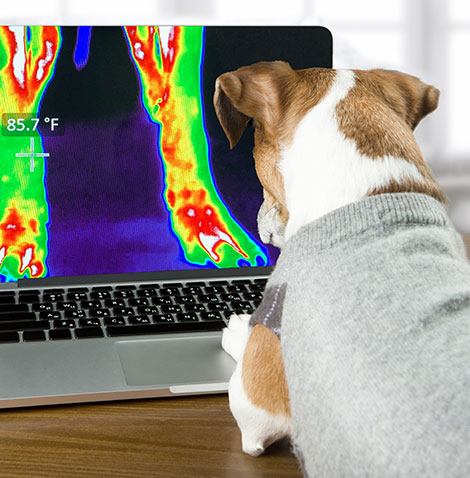Because You Want the Best
At Steele Creek Animal Hospital, we offer a wide range of rehabilitation services for dogs and cats to provide enhanced healing and yield dramatic improvements to their health and well-being. Dr. Young and her team utilize many innovative therapies to relieve pain, accelerate healing, and help pets return to a happier, more active life. With your involvement, we can create a safe and effective rehabilitation program that meets all of your pet’s unique needs.
Call (704) 588-4400 to schedule your pet’s rehabilitation appointment with us today

The Benefits of Rehabilitation
- Decrease inflammation
- Prevent muscle atrophy
- Restore and improve joint mobility
- Increase flexibility
- Decrease pain
- Improve strength
- Speed surgical recovery
- Improve agility
Rehabilitation Services
Hydrotherapy
Hydrotherapy
Our facility offers an underwater treadmill and swimming programs. Hydrotherapy helps to improve circulation, decreases inflammation, and builds up endurance. With it, we can treat:
- Osteoarthritis, intervertebral disc disease, and hip and elbow dysplasia
- Cruciate ligament injury, post-op orthopedic and neurologic recovery
- Vestibular disease, degenerative myelopathy, and fibrocartilaginous embolism
- Cervical vertebral instability (Wobblers)
Hydrotherapy also helps overweight pets and canine athletes, strengthening the heart and providing total body conditioning in a safe, controlled environment.
Thermography
Thermography
Thermography, or digital thermal imaging, is a non-invasive diagnostic tool that shows us the distribution of heat in your pet’s body, which can alert us to areas of inflammation or poor circulation. Thermography can be used effectively in conjunction with laser therapy to treat inflammation and low blood circulation and relieve pain.
Laser Therapy
Laser Therapy
Laser therapy is a non-invasive healing modality that uses photo energy to heal damaged tissues and bone, relieve pain, reduce inflammation and swelling, and improve circulation. With these effects, we can help your pet regain their mobility and live more comfortably overall.
Indications for laser therapy often include:
- Arthritis
- Hip and elbow dysplasia
- Ligament and tendon injuries
- Edema
- Soft tissue wounds
- Lick granulomas
- Burns
- Skin and ear infections
- Post-surgical incisions
- Gingivitis
Acupuncture
Acupuncture
Acupuncture plays an important role in pet rehabilitation. This holistic, drug-free treatment uses very small, thin needles to stimulate different points on the body and release a variety of pain-killing hormones. In other words, acupuncture uses your pet’s own pain-relieving and healing abilities to treat their problem. With acupuncture treatments, we can improve your pet’s immune system functioning, increase their circulation, relieve muscle pain, and decrease inflammation. Indications for acupuncture typically include nervous disorders, immune system dysfunction, gastrointestinal disorders, skin diseases, heart and kidney disease, and musculoskeletal conditions.
Therapeutic Ultrasound
Therapeutic Ultrasound
Therapeutic ultrasound generates vibrations that can help to increase blood flow to tissues, decrease pain and muscle spasms, speed wound healing, decrease inflammation, and increase the extensibility of muscle, tendon, and ligament tissues. Conditions that best benefit from this treatment include tendinopathies, muscle injuries (iliopsoas tears), wounds, and bone fractures.
Neuromuscular Stimulation
Neuromuscular Stimulation
Used for pain control, this innovative therapy reduces swelling and edema from injured or surgical tissues, stimulates neurologic pathways and sensations, and recruits muscle fibers and muscle reeducation in pets with muscle atrophy or weakness.
Pain Management
Pain Management
Chronic pain is a stressful condition that can increase blood pressure and cortisol levels and affect the various pathways of the nervous system. This pain can greatly reduce your pet’s quality of life and slow their ability to recover from injury or surgery. To safely and effectively manage your pet’s pain, we may integrate one or more of the following into their treatment:
- Pharmaceuticals
- Nutriceuticals
- Physiotherapy
- Exercise, hydrotherapy
- Nursing care
- Acupuncture, laser therapy, or shock wave therapy
- Home environment modification and assistive devices
- Platelet Rich Plasma (PRP) and/or stem cell therapy
Manual Therapy
Manual Therapy
With manual therapy, we can incorporate stretching, range of motion exercises, massage, and joint mobilization into your pet’s treatment plan. We can also apply heat (thermotherapy) and/or cold (cryotherapy) to aid in the repair of damaged tissues. Manual therapy can help to improve circulation, decrease swelling, decrease pain, and improve flexibility.
Assistive Devices
Assistive Devices
For pets with a lengthy or incomplete recovery from an injury and/or surgery, we can provide ambulation assistance with custom harnesses, carts, braces, slings, splints, and foot protection. We can also offer assistance in cart fitting and training. The goal of our assistive devices is to help your recovering pet go about their day-to-day life in comfort and with as little difficulty as possible.
Special Needs Boarding
Special Needs Boarding
Steele Creek Animal Hospital’s team of therapists, technicians, and assistants can provide special needs boarding to manage your pet’s care in a safe, comfortable environment while also meeting all their rehabilitation needs. Many of our clients travel great distances to have expert rehabilitation care for their pets; our boarding service makes it possible for pets to receive treatment on a daily basis. We can also meet the needs of pets who are a little more difficult to manage at home due to their size, the extent of their disability, or your busy schedule.
Therapeutic Exercise
Therapeutic Exercise
The goal of therapeutic exercise for pets is to improve the use of an affected limb, reduce pain, improve balance and proprioception, improve muscle mass and strength, improve daily function, and prevent further injury.
Exercise can accelerate recovery and improve your pet’s emotional state as well. Activities we can offer include balance exercises, slow and patterned walking, cavalettis, physiorolls and theraballs, stair climbing, sit to stand exercises, weight pulling, and ball playing.











